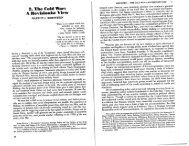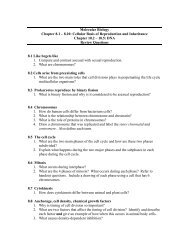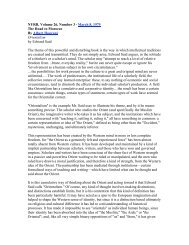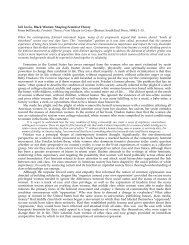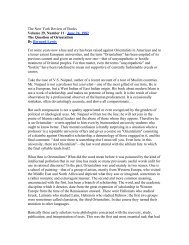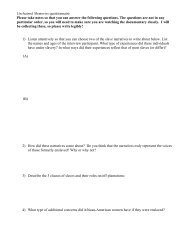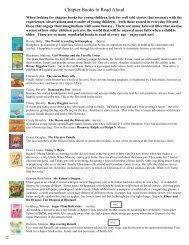testified, so “I was obliged to Submit” to each of them inturn. Her fate was hardly enviable, yet far worse were the circumstancesof girls living on Staten Island and in New Jersey,who during the <strong>fall</strong> and winter of 1776 were subjected torepeated rapes by British troops stationed in the area. Whereasthe Connecticut incidents and other similar occurrences tookplace in the context of brief excursions in search of plunder, the1776 rapes were both systematic and especially brutal....Depositions collected by the Continental Congress gave themost vivid accounts of the experiences of women in New Jerseyin late 1776. Particularly revealing are those that pertain to aseries of incidents at the home of Edmund Palmer, an elderlyHunterdon County farmer. One December day, a number ofBritish soldiers from a nearby camp came to the house. Oneof them dragged Palmer’s thirteen‐year‐old granddaughter,Abigail, into a back room. She “Scream’d & begged of himto let her alone, but some of Said Soldiers said they wou’dknock her Eyes out if she did not hold her Tongue.” Over theineffectual pleas of her grandfather and her aunt Mary Phillips,Abigail was raped three rimes. Abigail testified that “for threeDays successively, Divers Soldiers wou’d come to the House &Treat her in the Same manner.” On one of those days, her auntMary was raped in the barn and her friend Sarah Cain, whohad come to comfort her, was also assaulted. Finally, on theevening of the third day two soldiers demanded that Abigail andSarah’s younger sister Elisabeth, who was fifteen, accompanythem to their camp. “One of them Said he had come for hisGirl, & Swore he wou’d have her, & Seiz’d hold of her Hand& told her to Bundle up her Cloaths for she shou’d go withthem,” Abigail recounted. She and Elisabeth were then forcedinto another room despite the efforts of Edmund Palmer andElisabeth’s father, Thomas. Elisabeth recalled that “the saidSoldiers Ravished them both and then took them away to theirCamp, where they was both Treated by some others of theSoldiers in the same cruel manner,” until they were rescued byan officer. After spending the night at a nearby farmhouse, thegirls went home—not to Palmer’s, but to Thomas Cain’s. Andthere they were evidently safe, for they told the investigators ofno further attacks....What distinguished the war in Virginia, Georgia, and theCarolinas from that in the North was its length and ferociousintensity. From the invasion of Georgia in 1778 to the ratificationof the peace treaty in 1783, the South was the main theater ofwar, and there battles were not confined to the formal clashesbetween armies that had characterized the northern phase ofthe conflict. A prolonged guerrilla war, coupled with sporadicnonpartisan plundering and the wanderings of the Britisharmy through North Carolina and Virginia in 1780‐1781, leftmuch of the South devastated. David Ramsay’s assessment ofSouth Carolina can accurately be applied to the entire region:“]here was scarcely an inhabitant of the State, however obscurein character or remote in situation, whether he remained firmto one party or changed with the times, who did not partakeof the general distress.”Thus Georgians and South Carolinians universally complainedof the “Banditti” who raided, pillaged, and looted throughtheir states. “Property of every kind has been taken from usInhabitants, their Negroes, Horses & Cattle drove & carriedaway,” declared a Georgian in 1779. That same year a SouthCarolinian commented that the “Havoc” caused by the robbers“is not to be described. Great Numbers of Women and Childrenhave been left without a 2nd Shift of Clothes. The furniturewhich they could not carry off they wantonly broke, burnt, anddestroyed.” Fifteen months later Eliza Lucas Pinckney observedthat “the plantations have been some quite, some nearly windand all with very few exceptions great sufferers!. T]heir Crops,stock, boats, Carts etc. all gone taken or destroyed and theCrops made this year must be very small by the desertion ofthe Negroes in planting and hoeing time.” Virginia was notso seriously affected as its neighboring states to the south,but there too the distress was great in the months before theAmerican victory at Yorktown. Eliza Wilkinson’s account of herlife in the South Carolina Sea Islands during the 1780 Britishinvasion dramatically conveys the sense of fear and uncertaintyshe felt. The area was completely at the mercy of the redcoats,she noted, with “nothing but women, a few aged gentlemen,and (shame to tell) some skulking varlets” to oppose them. Onone “day of terror” in early June, she recounted, a British troopaccompanied by armed blacks robbed her home of clothes andjewelry, using “the most abusive language imaginable, whilemaking as if to hew us to pieces with their swords.” After thelooters had left, “I trembled so with terror, that I could notsupport myself,” she wrote two years later, recalling that shehad “indulged in the most melancholy reflections. The wholeworld appeared to me as a theatre, where nothing was actedbut cruelty, bloodshed, and oppression; where neither agenor sex escaped the horrors of injustice and violence; wherethe lives and property of the innocent and inoffensive were incontinual danger, and the lawless power ranged at large.” Inthe aftermath of the attack, Mrs. Wilkinson revealed, ‘’[Wecould neither eat, drink, nor sleep in peace; for as we lay inour clothes every night, we could not enjoy the little sleep wegot.... Our nights were wearisome and painful; our days spentin anxiety and melancholy.”But what to Eliza Wilkinson and her fellow whites was atime of trouble and distress was for their slaves a period ofunprecedented opportunity. The continuing presence of theBritish army in the South held out to black men and womenalike the prospect of winning their freedom from bondage,for in an attempt to disrupt the Americans’ labor supply andacquire additional manpower, British commanders offeredliberty to slaves who would flock to the royal standard. No sex111
or age restrictions limited the offer to adult men alone, and sowomen fled to the redcoat encampments, often taking theirchildren with them.The detailed plantation records kept by Thomas Jefferson andJohn Ball make it possible to identify the family relationshipsof runaways from their lands. Among the twenty‐three slaveswho abandoned Jefferson’s Virginia holdings were ten adultwomen and three girls. Of the five female adults who can betraced with certainty, two left with their husbands, one ofthem accompanied by children as well; another fled with threeof her four offspring; and the remaining two, one of whom wasmarried, ventured forth by themselves. The fifty‐three blackswho fled John Ball’s plantation in 1780 included eighteenwomen, among them eight mothers with children, some of thelatter still infants. Charlotte, a childless woman whose familyconnections are unknown, probably led a mass escape fromBall’s Kensington quarter. She originally left the plantation onMay 10, in company with Bessy and her three children, butshe was soon recaptured. A week later she ran away again, thistime along with (and perhaps as a guide for) what Ball termed“Ping’s gang.” This fifteen‐member group, which escaped viaBall’s flatboat, was composed of Pino, his wife, their youngestdaughter, and one of their two granddaughters; their daughter,Jewel, her husband, Dicky, and son, Little Pino; Dicky’s sister,her husband, and their daughter; and Eleanor Lawrence, herhusband, Brutus, and their two daughters. Although it is notclear whether Eleanor was related to the Pino clan, her sisterFlora had also absconded to the British, along with an infantson, two weeks previously.The impressions one receives from such fragmentary evidence—both of large numbers of female runaways and of familiesleaving together—are confirmed by an examination of recordskept at the evacuation of New York City. Each time the Britishleft an American port in the later years of the war, they carriedlarge numbers of former slaves away with them, approximatelyten thousand from Savannah and Charleston alone. Because thepreliminary peace terms accepted in November 1782 includeda clause requiring the British to return slaves to Americanowners, Sir Guy Carleton, the British commander, ordered theenumeration of all blacks who claimed the protection of thearmy. Crude biographical details were obtained from formerslaves then ˇ.within the lines in order to ascertain whetherthey should be allowed to embark with the troops for Englandand Nova Scotia. Blacks who had belonged to loyalists wereexcluded from the promise of freedom offered by the Britishduring the war, as were any who had joined the British afterNovember 1782. But Carleton believed himself obliged toensure the liberty of all the others.Of the 2,863 persons whose sex is specified on the survivingembarkation lists (119 small children were not differentiated bysex), 1,211 (or 42.3 percent) were female and 1,652 (57.7 percent)were male. The substantial proportion of female runawaysreflects the ease with which even a woman with children couldseek freedom when the British army was encamped only a fewmiles from her home. Further, the analysis of the age structureof those on the New York City lists indicates that women oftenbrought children with them into the lines. Nearly 17 percentof the refugees were nine years of age or younger, and fully 32percent were under twenty. Slightly more than a quarter of themature women were explicitly identified as being accompaniedby children, and the addition of other likely cases brings thatproportion to 40 percent. Disregarding the 96 children whohad been born free in British‐held territory, each maturewoman who joined the royal forces had an average of 1.6children at her side.An examination of familial relationships from the standpointof 605 children (503 of them nine years old or under) listed onthe embarkation rolls shows that 3 percent were accompaniedsolely by fathers, 17 percent were with both parents, 56.2percent with mothers alone, and 24.3 percent with otherrelatives, some of whom may have been parents but who are notexplicitly noted as such on the occasionally incomplete records.These families included such groups as Prince Princes, agedfifty‐three, his forty‐year‐old wife, Margaret, their twentyyear‐olddaughter, Elizabeth, and her “small child,” and theirson, Erick, who was eleven; “Jane Thompson 70 worn out wta grand child 5 y[r] old”; and Hannah Whitten, thirty, withher five children, ages eight, seven, six, five, and one. Thefive‐member Sawyer clan of Norfolk, Virginia, evidently usedthe opportunity to seek freedom with the British as a meansof reuniting. Before they all ran away in 1776, the family wasdivided among three owners: the mother and a child in onelocation, two children in another, and the father in a third. Inall, despite the preponderance among the refugees of young,single adults, 40 percent of the total, like the Sawyers and theothers just noted, appear to have been accompanied by relativesof some kind.To arrive at New York City, the blacks listed on the Britishrecords had had to survive many dangers and hardships, not theleast of which was the prevalence of epidemic diseases in theencampments to which they had fled. Yet they were not entirelysafe even in British‐occupied Manhattan. The minutes of thejoint Anglo‐American board established to adjudicate claimsunder the peace treaty reveal liberty lost on legal technicalitiesimportant to the presiding officers but of little meaning to theblacks involved. Mercy and her three children were returned toher master because, as a resident of Westchester County, NewYork, she had not lived outside the British lines and so couldnot have come within them voluntarily to earn the protectionof the freedom proclamation. Elizabeth Truant remained theproperty of a New Jerseyite because she had not joined theBritish until April 1783, after the signing of the preliminary112 <strong>fieldston</strong> <strong>american</strong> <strong>reader</strong> <strong>volume</strong> i – <strong>fall</strong> <strong>2007</strong>
- Page 4 and 5:
the federalist papers #51 (1787)...
- Page 6 and 7:
Inventing An AmericaCrèvecoeur Dis
- Page 8 and 9:
I say to you today, my friends, tha
- Page 10 and 11:
melodies of the Negro slave; the Am
- Page 12 and 13:
31.the encounterand north americasu
- Page 14 and 15:
Native American PoetryWHEN SUN CAME
- Page 16 and 17:
Pagans and Pilgrims in the Promised
- Page 18 and 19:
Reverend Doctor Sepulveda has spoke
- Page 20 and 21:
Juan Gines de Sepulveda:“The Grea
- Page 22 and 23:
Nathaniel Bacon: Bacon’s Declarat
- Page 24 and 25:
The sale of human beings in the mar
- Page 26 and 27:
seeking great things for ourselves
- Page 28 and 29:
Therefore, let every one that is ou
- Page 30 and 31:
frontier village she revised her ea
- Page 32 and 33:
Edward Taylor: Poems (1642—I729)L
- Page 34 and 35:
The Mayflower CompactNovember 11, 1
- Page 36 and 37:
fly kites and shoot marbles, and to
- Page 38 and 39:
Dominie Van Shaick, the village par
- Page 40 and 41:
another man. In the midst of his be
- Page 42 and 43:
Washington Irving:The Legend of Sle
- Page 44 and 45:
a kind of idle gentlemanlike person
- Page 46 and 47:
Tassel. In this enterprise, however
- Page 48 and 49:
on the top of his nose, for so his
- Page 50 and 51:
however, turned upon the favorite s
- Page 52 and 53:
the green knoll on which stands the
- Page 54 and 55:
so any nation, that discovers an un
- Page 56 and 57:
indefatigable measures, the cause o
- Page 58 and 59:
their heads on their shoulders inst
- Page 60 and 61:
Metacomet Cries Out for RevengeIn t
- Page 62 and 63: Gustavus Vassa: The Interesting Nar
- Page 64 and 65: duct, and guard them from evil. The
- Page 66 and 67: particularly at full moons; general
- Page 68 and 69: that might come upon us; for they s
- Page 70 and 71: size of the finger nail. I was sold
- Page 72 and 73: intolerably loathsome, that it was
- Page 74 and 75: as he instinctively guessed its app
- Page 76 and 77: Document DSource: Articles of Agree
- Page 78 and 79: Next to manners are the exterior gr
- Page 80 and 81: Howard Zinn: Columbus, the Indians,
- Page 82 and 83: same token covet the possessions of
- Page 84 and 85: and culture, to ensnare ordinary pe
- Page 86 and 87: Fire Brand, and putting it into the
- Page 88 and 89: included the Mohawks (People Of the
- Page 90 and 91: It has been tempting to dismiss Jef
- Page 92 and 93: she found herself back in prison. M
- Page 94 and 95: 311.the struggle forindependence176
- Page 96 and 97: John Locke: of Civil Government (16
- Page 98 and 99: Daniel Dulany: “Considerations”
- Page 100 and 101: First Continental Congress, Declara
- Page 102 and 103: colonies enabled her to triumph ove
- Page 104 and 105: and America is a strong and natural
- Page 106 and 107: considerable pecuniary resources, b
- Page 108 and 109: He has combined with others to subj
- Page 110 and 111: Mary Beth Norton:Women in the Revol
- Page 114 and 115: peace terms. And, tragically, Samue
- Page 116 and 117: not that this glorious threesome ne
- Page 118 and 119: less powerful than the rest, as it
- Page 120 and 121: paramount culture, but to many for
- Page 122 and 123: James Kirby Martin: Protest and Def
- Page 124 and 125: 3111.developing a frameworkfor gove
- Page 126 and 127: The Articles of Confederation (1777
- Page 128 and 129: 7. Whenever the Confederate Lords s
- Page 130 and 131: Darkness there, and nothing more.De
- Page 132 and 133: Edgar Allen Poe:The Fall of the Hou
- Page 134 and 135: of unnatural sensations. Some of th
- Page 136 and 137: the full extent, or the earnest aba
- Page 138 and 139: paused; for it appeared to me (alth
- Page 140 and 141: Walt Whitman:Poetry Crossing Brookl
- Page 142 and 143: 101 Flow on, river! flow with the f
- Page 144 and 145: 41 Nor any more youth or age than t
- Page 146 and 147: 136 I am not an earth nor an adjunc
- Page 148 and 149: 13225 The negro holds firmly the re
- Page 150 and 151: 322 Patriarchs sit at supper with s
- Page 152 and 153: 415 And if each and all be aware I
- Page 154 and 155: 511 Voices of cycles of preparation
- Page 156 and 157: 27611 To be in any form, what is th
- Page 158 and 159: 702 Head high in the forehead, wide
- Page 160 and 161: 806 I go hunting polar furs and the
- Page 162 and 163:
908 Ten o’clock at night, the ful
- Page 164 and 165:
1001 I do not ask who you are, that
- Page 166 and 167:
1099 Believing I shall come again u
- Page 168 and 169:
1200 The great Camerado, the lover
- Page 170 and 171:
1294 And as to you Corpse I think y
- Page 172 and 173:
James Madison:The Federalist Papers
- Page 174 and 175:
James Madison:The Federalist Papers
- Page 176 and 177:
people are impliedly and incidental
- Page 178 and 179:
sort of people, who are orderly and
- Page 180 and 181:
Charles Beard: The ConstitutionA Mi
- Page 182 and 183:
Legislatures reflect these interest
- Page 184 and 185:
Staughton Lynd:The Conflict Over Sl
- Page 186 and 187:
France is an example. Jefferson had
- Page 188 and 189:
to the interior & landed interest,
- Page 190 and 191:
The first was to solve the problem
- Page 192 and 193:
there against mobs, demagogues, and
- Page 194 and 195:
3iv.the early republic: forging ana
- Page 196 and 197:
Alexander Hamilton and Thomas Jeffe
- Page 198 and 199:
employment to industrious individua
- Page 200 and 201:
Hamiltonian Federalists and Jeffers
- Page 202 and 203:
“As the present crisis of human a
- Page 204 and 205:
The Kentucky Resolutions of 1799The
- Page 206 and 207:
Washington’s Farewell Address,Sep
- Page 208 and 209:
equal law must protect, and to viol
- Page 210 and 211:
I sec.8, Congress has also been gra
- Page 212 and 213:
That the following amendments of th
- Page 214 and 215:
3v.the disgusting spirit ofequality
- Page 216 and 217:
Transcendentalism DefinedThough clo
- Page 218 and 219:
All are needed by each one;Nothing
- Page 220 and 221:
a long period continue, to rule is
- Page 222 and 223:
The broadest and most prevalent err
- Page 224 and 225:
clergyman whose preaching my father
- Page 226 and 227:
difference between resisting this a
- Page 228 and 229:
similar concern for the conditions
- Page 230 and 231:
few years I have been gravely disap
- Page 232 and 233:
In the midst of blatant injustices
- Page 234 and 235:
about the baby, whom she had hardly
- Page 236 and 237:
who, with conjugal affections and m
- Page 238 and 239:
a hut, tranquil, if in a crowd. The
- Page 240 and 241:
South Carolina Ordinance of Nullifi
- Page 242 and 243:
operation....The right to secede is
- Page 244 and 245:
Worcester v. Georgia and refused to
- Page 246 and 247:
effect in point of possession when
- Page 248 and 249:
hold the writer maintained with the
- Page 250 and 251:
986A narrow Fellow in the GrassOcca
- Page 252 and 253:
house.“You done talk too much wid
- Page 254 and 255:
Kate Chopin: The StormIThe leaves w
- Page 256 and 257:
IVAlcée Laballière wrote to his w
- Page 258 and 259:
When the letter reached Desiree she
- Page 260 and 261:
Her lip was beginning to tremble, a
- Page 262 and 263:
IIITheir eyes met, and she blushed
- Page 264 and 265:
een reversed.“Why, how do you do?
- Page 266 and 267:
of a juggler tossing knives; but th
- Page 268 and 269:
Having deprived her of this first r
- Page 270 and 271:
Sojorner Truth: Ain’t I A Woman?S
- Page 272 and 273:
Viewpoints of the Mexican WarThe fo
- Page 274 and 275:
evolt and sin...”Caleb Atwater, E
- Page 276 and 277:
encouraged this ideal of the perfec
- Page 278 and 279:
its own territory, with boundaries
- Page 280 and 281:
3vi.slavery, sectionalismand secess
- Page 282 and 283:
Charles W. Chestnut:The Passing of
- Page 284 and 285:
promptness and decision. “He’s
- Page 286 and 287:
left the hotel when a long‐haired
- Page 288 and 289:
and sent to the penitentiary. I tho
- Page 290 and 291:
Necessary Evil to Positive GoodSour
- Page 292 and 293:
Dred Scott vs Sanford (1857)The fol
- Page 294 and 295:
The Lincoln-Douglas Debates (1858)I
- Page 296 and 297:
DBQ: Free Soil, Free Labor, Free Me
- Page 298 and 299:
of the slave-holding system is to d
- Page 300 and 301:
“Why, not a cruel man, exactly, b
- Page 302 and 303:
Lincoln Denies Racial EqualityInter
- Page 304 and 305:
through an unseen multitude.“Ther
- Page 306 and 307:
that they intercepted, even for a m
- Page 308 and 309:
earded elders of the church have wh
- Page 310 and 311:
speak of. What! I have authority, I
- Page 312 and 313:
nothing to be shunned in the handso
- Page 314 and 315:
summer sun, it was his father’s c
- Page 316 and 317:
a human form appeared at intervals,



